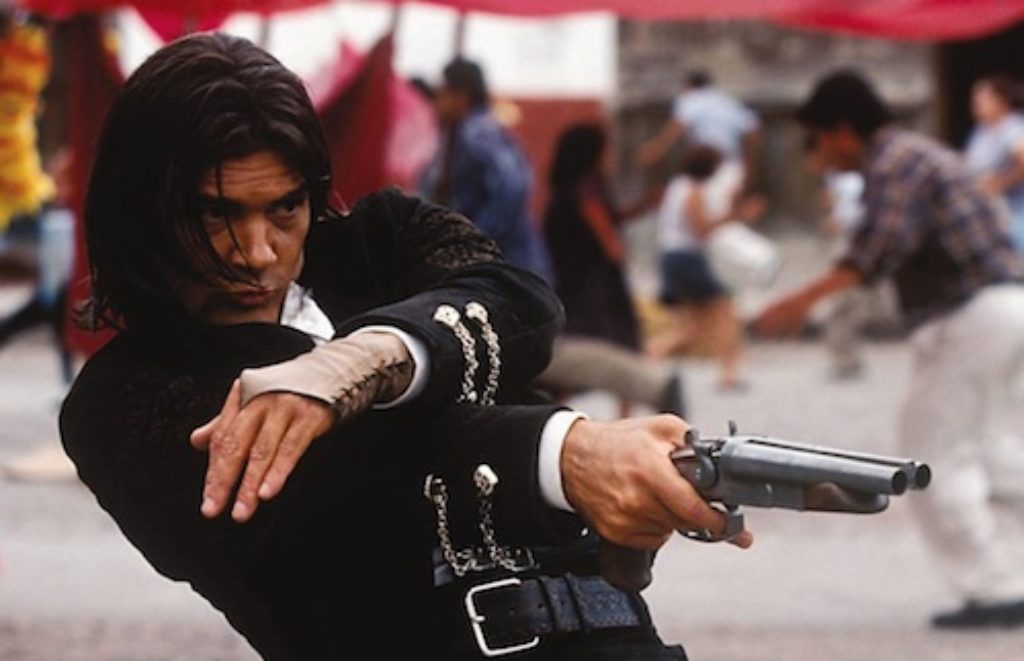
Once Upon a Time in Mexico is the third in a trilogy of motion pictures (preceded by El Mariachi and Desperado) about the guitar-and-gun slinging El Mariachi. In it, unbeknownst to him, the president of Mexico’s life is in danger and a coup d’etat is in the works. Behind the plot is evil drug lord Barillo. To foil the assassination, CIA agent Sands—who is as corrupt and morally bankrupt as Barillo—seeks the assistance of Mariachi who has withdrawn into a life of solitude following personal tragedy. Mariachi agrees to help—not so much because he cares about the country’s peril, but because he’s seeking revenge. Devastated after the murder of his wife and daughter years earlier, Mariachi hopes to get even with the wielder of the sword, General Marquez, who happens to be in league with Barillo. Meanwhile, Sands recruits retired FBI agent Jorge Ramirez, who also has a grudge against Barillo (Barillo was responsible for torturing his former partner).What transpires is a violent shoot-‘em-up as El Mariachi, Sands and Co. track the worst bad guys in a cast full of bad guys, in the hope of evening old scores … and saving Mexico in the process.
positive elements: It’s obvious Mariachi cared deeply for his wife and daughter. Mariachi and his friends risk their lives to save Mexico’s president, although revenge—not political concerns—drive them. The Mexican president expresses a willingness to die for what is right.
spiritual content: Mariachi enters a confessional and asks for forgiveness before it is shot to smithereens by Barillo’s men. After killing several, he crosses himself, then continues his violent counter-assault. A woman is seen calmly praying in the church despite the fact it has become a bloody war zone. As Mariachi exacts revenge against Marquez, he declares that he’s sending him to hell. A hospital wall displays a crucifix.
sexual content: Dancers in a Mexican bar wear ultra-skimpy bikinis and a proprietor advertises that sex is available for 50 pesos. Carolina wears low-cut, revealing outfits. Sands and a Mexican agent kiss as Sands puts a gun under her chest and pulls the trigger (the result is quite bloody).
violent content: A number of scenes involve PG violence (i.e., a motorcycle crashes, a vehicle smashes into a cart, a gasoline truck explodes, a guitar is broken over a thug’s head). But the MPAA rated this film R because of “strong violence and language” for good reason. Mexico boasts a high body count and features excessive, vicious and very bloody brutality.
Life is extremely cheap here and people are killed for absolutely no reason. Sands murders the cook in a restaurant (three bloody holes are seen in his chest afterwards) because he enjoyed the food. He excuses his action by saying he’s helping restore restaurant equality. He also kills an informant and a waitress. In flashback, Carolina is shown pulling up her dress to reveal daggers in her garter belt. She reaches for three, sends them sailing at a trio of bad guys, and impales each in the forehead. Using martial arts, she manhandles various thugs, and shoots one at point blank range.
One of Barillo’s men kills a vendor at a market to show he means business. Mariachi shoots a thug, sending his body flying into the air and crashing into a pew. A matador is gored by a bull in a rigged bullfight. A man is strangled with a chain. In flashback, Mariachi’s wife and daughter are brutally gunned downed. Mariachi kicks a thug in the groin and grabs two others in the same region. General Marquez kills a messenger.
A needle is shown being injected into a person’s skin. Doctors and nurses are ambushed while performing surgery (blood spatters against the walls as bodies are strewn across the floor). A patient’s face is shown grotesquely brutalized and bloodied. A person is rifle-butted in the eye. A guitar case (which doubles as a flame thrower) is used to torch people. Mariachi ultimately gets his revenge in an extremely gruesome scene that includes bullets taking out chunks of flesh and bone. A thug takes a drill to Sands’ eyes. Subsequent scenes show that both of his eyes have been drilled out. Blind, Sands continues to kill people. A rocket grenade takes out soldiers. The coup d’etat turns city streets into a battle zone.
crude or profane language: Approximately 20 f-words (some subtitled) join a half-dozen s-words, a few profane uses of “god” combined with “d–n,” and two obscene put-downs that allude to oral sex. Sands uses one f-word against a young boy, and makes an obscene gesture.
drug and alcohol content: Sands smokes constantly, often exhaling nasally. He drinks shots and says his favorite is tequila and lime. A bartender informant also imbibes. Several scenes take place in bars with patrons drinking. People drink at a presidential banquet. One of Mariachi’s cohorts is a drunk, who at one point remarks, “I don’t think—I drink!”Although the camera doesn’t zoom in, nor does the character promote drugs by anything he says or does, perceptive moviegoers will no doubt notice that in one scene Sands wears a belt with a prominent marijuana leaf imprinted on its buckle.
other negative elements: A man vomits in an alley. Sands pulls an eye patch off a dead man revealing a bag-filled socket. He reaches a gloved hand up the corpse’s rectum searching for something, then attempts to sink the body in a lake.
conclusion: Violence for the sake of violence, and a boatload of profanities send this movie south rather quickly. But even film-editing services won’t be able to rescue this one. There’s no substance. No real heroes (Mariachi is as close to one as they come here, but his gun-totin’ vengeance is hardly something to write home about). So what moviegoers end up with is a lot of bloody violence in an vacant, amoral framework. It’s disturbing. It’s confusing. It’s irritating. Here’s hoping the next time director Robert Rodriguez decides to do a sequel he sticks with Spy Kids.